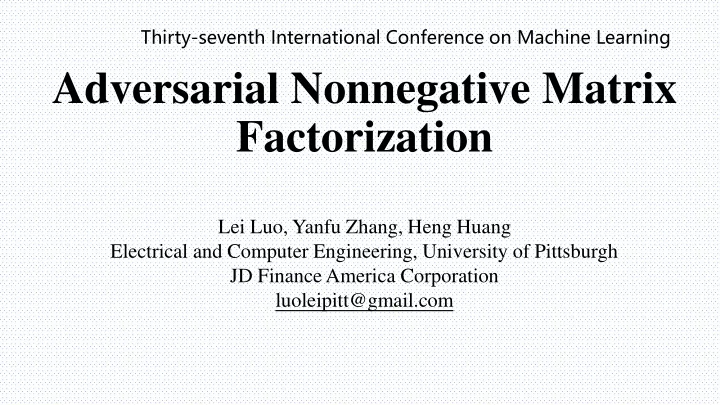

Thirty-seventh International Conference on Machine Learning Adversarial Nonnegative Matrix Factorization Lei Luo, Yanfu Zhang, Heng Huang Electrical and Computer Engineering, University of Pittsburgh JD Finance America Corporation luoleipitt@gmail.com
Outline ➢ Background ➢ Motivation ➢ Our Work ➢ Experiments
Outline ➢ Background ➢ Motivation ➢ Our Work ➢ Experiments
Background ➢ The nonnegative matrix factorization (NMF) has been a prevalent nonnegative dimensionality reduction method ➢ feature extraction, video tracking, image processing, and document clustering. ➢ Popular models: standard NMF, RNMF(Truncated Cauchy NMF) ➢ What is the aim of nonnegative matrix factorization ? ➢ It targets to factorize an m × N -dimensional matrix Y into the product AX of two nonnegative matrices, with n columns in A , where n is generally small. ➢ What make the success of nonnegative matrix factorization? ➢ Successfully fitting noise term: ➢ Novel training approaches in model design
Outline ➢ Background ➢ Motivation ➢ Our Work ➢ Experiments
Motivation ➢ The limitations of some existing methods ➢ Existing methods are only suitable for some special types of noises, e.g., Laplacian or Cauchy noise, which cannot flexibility show the in facing the worst-case (i.e., adversarial) perturbations of data points. ➢ Our method ➢ We introduce a novel Adversarial Nonnegative Matrix Factorization (ANMF) model by emphasizing potential test adversaries that are beyond the pre- defined constraints.
Outline ➢ Background ➢ Motivation ➢ Our Work ➢ Experiments
Our work ➢ NMF can be formulated as: (1) Assumptions: 1. the learned feature data A and given data Y are drawn from an unknown distribution at training time. The test data can be generated either from , the same distribution as the training data, or from , a modification of generated by an attacker. 2. The action of the learner is to select parameters of the Eq. (1). The attacker has an instance-specific target, and encourages that the prediction made by learner on the modified instance, , is close to this target.
Our work ➢ The cost functions of each learner (Cl) and the attacker (Ca) are estimated by: ➢ Ultimately, our model is expressed as: (2) Theorem 1. Given X , the best response of the attacker is (3)
Since there is an inverse of complicated matrix in (3), it is difficult to solve problem (2) by directly substituting (3) into (2). To mitigate this limitation, we consider (3) as a constraint of (2), which leads to the following problem: (4) (4) (5)
Theoretical Analysis We define the empirical reconstruction error of NMF as follows:
➢ The proposed algorithm: We apply the Alternating Direction Method of Multipliers (ADMM) optimization algorithm to solve our problem
Our work Convergence Analysis: To simplify notations, let us define be a sequence generated by Algorithm 1 that satisfies the condition Theorem 4. Let Then any accumulation point of is a KKT point of problem (5).
Outline ➢ Background ➢ Motivation ➢ Our Work ➢ Experiments
Experiments
Experiments
Experiments
References • Guan, N., Liu, T., Zhang, Y., Tao, D., and Davis, L. S. Truncated cauchy non-negative matrix factorization for robust subspace learning. IEEE Transactions on Pattern Analysis and Machine Intelligence, 2017. • Farnia, F., Zhang, J. M., and Tse, D. Generalizable adversarial training via spectral normalization. arXiv preprint arXiv:1811.07457, 2018. • Hajinezhad, D., Chang, T.-H., Wang, X., Shi, Q., and Hong, M. Nonnegative matrix factorization using admm: Algorithm and convergence analysis. In Acoustics, Speech and Signal Processing (ICASSP), 2016 IEEE International Conference on, pp. 4742 – 4746. IEEE, 2016. • ……
Recommend
More recommend